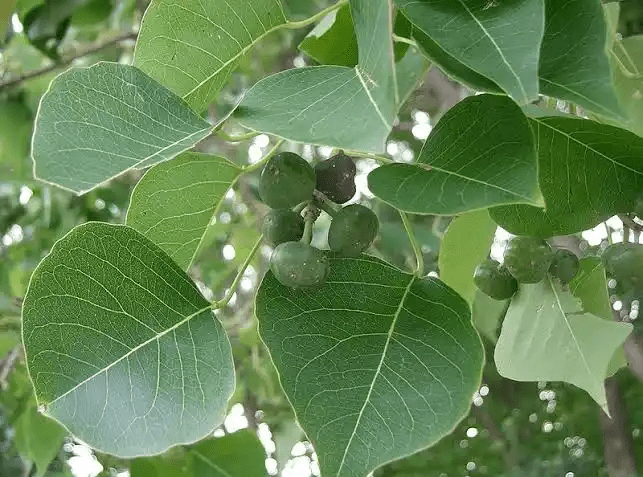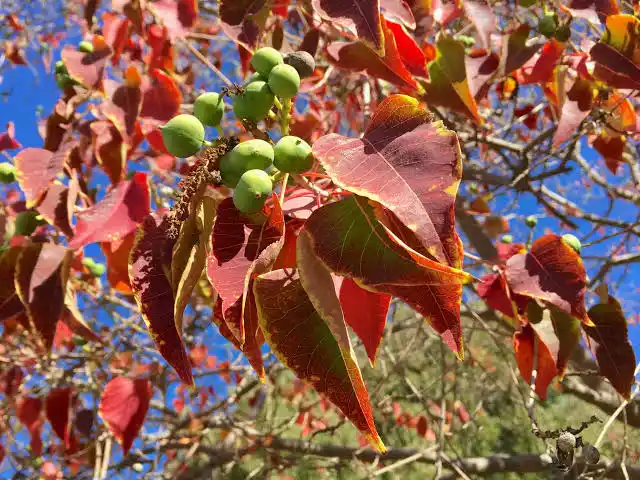Triadica sebifera, commonly known as the Chinese tallow tree or popcorn tree, is a deciduous tree belonging to the Euphorbiaceae family. Native to eastern Asia, particularly in China and Taiwan, this tree has been introduced to various regions around the world for ornamental purposes and for the extraction of tallow, a waxy substance found in its seeds.
The Chinese tallow tree typically reaches a height of 15 to 20 meters, and it has a rounded crown with attractive, heart-shaped leaves. The leaves are glossy green in color during the growing season, turning vibrant shades of yellow, orange, and red in the autumn, creating a visually striking display. The tree produces small, inconspicuous flowers that are not particularly ornamental.
One of the most distinctive features of Triadica sebifera is its seeds, which are enclosed in three-lobed capsules. These capsules split open, revealing white, waxy seeds.
The waxy coating on the seeds, known as tallow, has industrial uses and is traditionally used in the production of soap and candles. However, the extraction of tallow from Chinese tallow trees has raised environmental concerns in some regions, as the tree has a reputation for invasiveness.
Chinese tallow trees have been introduced to various parts of the world, including the southern United States, where they have become invasive in certain ecosystems.
Their ability to produce a large number of seeds, coupled with their adaptability to a wide range of soil types and climates, has led to the displacement of native vegetation in some areas.
Despite its invasive tendencies, Triadica sebifera is still cultivated as an ornamental tree in landscapes and gardens. The attractive foliage and the tree’s ability to thrive in various soil conditions make it a popular choice for those seeking a visually appealing and adaptable tree.
Efforts to manage the invasiveness of Chinese tallow trees include promoting the use of alternative, non-invasive species in landscaping and implementing control measures in affected natural habitats.
Triadica sebifera, the Chinese tallow tree, is a deciduous tree known for its ornamental value and the production of tallow from its seeds.
However, its invasive tendencies in certain regions have prompted environmental concerns, leading to efforts to manage and control its spread. Careful consideration of its impact on local ecosystems is essential when introducing this species to new areas.
The Botanical Description of Triadica sebifera
1. Shape and Size: Triadica sebifera, commonly known as the Chinese tallow tree, is a deciduous tree that can reach heights of 40 to 60 feet. It typically has a rounded crown and a straight, slender trunk. The overall shape is aesthetically pleasing, making it a popular ornamental tree.
2. Leaves: The leaves of Triadica sebifera are simple, alternate, and have a distinctive shape. They are broadly ovate with serrated margins and a pointed tip. During the fall season, the glossy green leaves turn vibrant shades of yellow, orange, and red, creating a stunning visual display.
3. Flowers: The tree produces small, greenish-yellow flowers in spring. The flowers are often inconspicuous, but en masse, they contribute to the overall appeal of the tree. The flowering period is a crucial stage in the reproductive cycle of Triadica sebifera.
4. Fruits: One of the distinctive features of Triadica sebifera is its fruit, known as a capsule. These capsules contain three seeds each, surrounded by a white, waxy substance. The waxy coating, known as tallow, gives the tree its common name and has various industrial uses.
5. Bark: The bark of Triadica sebifera is gray and becomes deeply furrowed as the tree matures. The bark serves as a protective layer for the tree and contributes to its resilience in various environmental conditions.
The Geographic Distribution of Triadica sebifera
1. Native Range: Triadica sebifera is native to eastern Asia, specifically in China and Taiwan. It has been cultivated and introduced to other parts of the world due to its adaptability and various uses.
2. Invasive Presence: While the Chinese tallow tree is native to Asia, it has become invasive in certain regions, particularly in the southeastern United States. Its rapid growth and ability to colonize disturbed areas have led to ecological concerns in these non-native environments.
3. Habitat Preferences: Triadica sebifera thrives in a variety of habitats, including disturbed areas, fields, and along water bodies. It exhibits adaptability to different soil types, contributing to its successful establishment in various ecosystems.
4. Ecological Impact: The spread of Triadica sebifera in non-native regions has raised ecological concerns. It can outcompete native vegetation, leading to changes in local ecosystems. The tree’s ecological impact is a subject of ongoing research and conservation efforts.
The Chemical Composition of Triadica sebifera
1. Tallow Content: The most notable chemical component of Triadica sebifera is the tallow found in its seeds. This waxy substance, when processed, can be used in the production of soap, candles, and biodiesel. The tallow content has both industrial and traditional applications.
2. Alkaloids: Triadica sebifera contains alkaloids, which are nitrogenous organic compounds. The presence of alkaloids contributes to the plant’s defensive mechanisms against herbivores and pests.
3. Phenolic Compounds: Phenolic compounds, known for their antioxidant properties, are found in Triadica sebifera. These compounds play a role in protecting the tree from oxidative stress and may have implications for human health.
4. Triterpenoids: Research has identified triterpenoids in Triadica sebifera, compounds that have demonstrated various biological activities, including anti-inflammatory and antimicrobial properties. The presence of triterpenoids adds to the plant’s chemical diversity.
5. Fatty Acids: The seeds of Triadica sebifera contain fatty acids, contributing to the oil content in the tallow. These fatty acids have industrial applications and may also have nutritional value.
The botanical description, geographic distribution, and chemical composition of Triadica sebifera paint a comprehensive picture of this versatile tree. From its aesthetic appeal to its ecological impact and chemical properties, the Chinese tallow tree offers a fascinating subject for study and appreciation.
Read Also: 10 Medicinal Health Benefits Of Tithonia diversifolia (Mexican Sunflower)
The Medicinal Health Benefits Of Triadica sebifera (Chinese Tallow Tree)

1. Anti-Inflammatory Properties: Triadica sebifera has been traditionally used for its anti-inflammatory effects. The plant contains compounds that may help reduce inflammation, making it potentially beneficial for conditions such as arthritis and inflammatory skin disorders.
2. Respiratory Health: The Chinese tallow tree has been associated with respiratory health benefits. Its use may help alleviate symptoms of respiratory conditions like coughs and bronchitis, providing relief and supporting overall respiratory well-being.
3. Antioxidant Effects: Triadica sebifera possesses antioxidant properties attributed to certain compounds present in the plant. Antioxidants help neutralize free radicals in the body, potentially contributing to cellular health and overall well-being.
4. Wound Healing: Traditional uses of Triadica sebifera include its application in wound healing. The plant’s properties may aid in the regeneration of tissues and accelerate the natural healing process.
5. Analgesic Action: The Chinese tallow tree has been utilized for its potential analgesic effects. This makes it a candidate for natural pain relief, providing an alternative for those seeking non-pharmaceutical options.
6. Anti-microbial Benefits: Some studies suggest that Triadica sebifera exhibits antimicrobial properties. These properties may contribute to its traditional use in addressing microbial infections, although more research is needed to fully understand its efficacy.
7. Digestive Support: Traditional medicine has employed Triadica sebifera for digestive support. It may help soothe digestive discomfort and contribute to overall gastrointestinal well-being.
8. Immune System Modulation: The plant has been traditionally associated with immune system modulation. Regular consumption or use may help modulate immune responses, potentially enhancing the body’s defense mechanisms.
9. Cardiovascular Health: Preliminary research indicates that Triadica sebifera may have cardiovascular benefits. It may contribute to heart health by supporting factors such as blood pressure and cholesterol levels.
10. Stress Reduction: Traditional practices involving Triadica sebifera suggest its potential role in stress reduction. The plant may have calming effects, offering support for individuals dealing with stress and anxiety.
The Methods of Usage to Achieve the Provided Health Benefits Of Triadica sebifera (Chinese Tallow Tree)
1. Herbal Teas and Infusions: One common method of utilizing Triadica sebifera is by preparing herbal teas and infusions. Boiling leaves or bark and creating a flavorful tea can be an enjoyable way to incorporate the plant into one’s routine.
2. Topical Applications: For wound healing and skin-related benefits, Triadica sebifera extracts can be used topically. Creating ointments or poultices allows for direct application to the affected areas.
3. Dietary Supplements: Capsules or tinctures made from Triadica sebifera extracts are available as dietary supplements. These offer a convenient way to obtain the plant’s medicinal benefits in concentrated forms.
4. Culinary Uses: In some cultures, Triadica sebifera leaves or extracts are included in traditional recipes. Incorporating the plant into the diet can provide a flavorful means of obtaining its health benefits.
5. Steam Inhalation: For respiratory health, inhaling steam infused with Triadica sebifera extracts may be beneficial. This method can help alleviate congestion and respiratory discomfort.
6. Poultices for Pain Relief: Applying poultices made from Triadica sebifera to areas experiencing pain can provide localized relief. This method is particularly useful for addressing discomfort associated with injuries.
7. Tinctures for Immune Support: Tinctures made from Triadica sebifera can be consumed to support immune system health. These concentrated extracts offer a potent dose of the plant’s beneficial compounds.
8. Herbal Baths: Adding Triadica sebifera extracts to bathwater is a method for obtaining benefits such as skin health and stress reduction. The absorption through the skin contributes to overall well-being.
The Side Effects Of Using Triadica sebifera Medicinal Plant
1. Allergic Reactions: Some individuals may be allergic to components of Triadica sebifera. Allergic reactions can manifest as skin irritation, itching, or respiratory issues. A patch test is advisable, especially for topical applications.
2. Gastrointestinal Discomfort: Excessive consumption of Triadica sebifera may lead to gastrointestinal discomfort, including nausea, vomiting, or diarrhea. It is crucial to adhere to recommended dosages.
3. Interaction with Medications: Individuals on medications, especially for specific health conditions, should consult healthcare professionals before incorporating Triadica sebifera into their routine. The plant may interact with certain drugs.
4. Not Recommended During Pregnancy: Pregnant women are generally advised to avoid using Triadica sebifera due to limited research on its safety during pregnancy. Consulting healthcare providers is essential.
5. Skin Sensitivity: When using Triadica sebifera extracts topically, individuals with sensitive skin should perform a patch test. Skin sensitivity can vary, and precautions should be taken to avoid adverse reactions.
6. Avoiding Excessive Dosages: While Triadica sebifera offers medicinal benefits, moderation is key. Excessive dosages may lead to unintended side effects, and users should follow recommended guidelines.
7. Monitoring for Individual Reactions: Users should monitor their individual reactions when using Triadica sebifera for the first time. Any unusual symptoms should prompt discontinuation and consultation with a healthcare provider.
Triadica sebifera, or the Chinese Tallow Tree, presents a range of medicinal health benefits, it is crucial to approach its usage with awareness of potential side effects and appropriate methods of application. Consulting with healthcare professionals ensures safe and effective integration into one’s wellness routine.
Read Also: How Farm and Care for Alaska Pollock Fish (Theragra chalcogramma)
The Scientific Research and Studies of Triadica sebifera (Chinese Tallow Tree)

1. Anti-Inflammatory Properties: Numerous scientific studies have investigated the anti-inflammatory properties of Triadica sebifera. Researchers have identified specific compounds within the plant that contribute to its ability to modulate inflammatory responses, providing a basis for its traditional use in treating inflammatory conditions.
2. Antioxidant Activity: Scientific research has delved into the antioxidant potential of Triadica sebifera. The presence of various antioxidants in the plant has been demonstrated to combat oxidative stress, showcasing its potential applications in promoting overall health.
3. Wound Healing Mechanisms: Studies exploring the wound-healing properties of Triadica sebifera have shed light on the mechanisms involved. The plant’s extracts have been found to accelerate the healing process through their influence on cellular activities and tissue regeneration.
4. Antimicrobial Efficacy: The antimicrobial efficacy of Triadica sebifera has been a subject of interest, with investigations into its effectiveness against a range of pathogens. This research is particularly relevant to understanding the plant’s traditional use in addressing infections.
5. Immunomodulatory Effects: Scientific studies have explored the immunomodulatory effects of Triadica sebifera, elucidating its potential in modulating immune responses. This research contributes to our understanding of the plant’s impact on the immune system.
6. Cardiovascular Health: Preliminary research indicates that Triadica sebifera may have cardiovascular benefits. Studies suggest potential positive effects on blood pressure and cholesterol levels, emphasizing its potential contribution to heart health.
7. Analgesic and Antipyretic Properties: The analgesic and antipyretic properties of Triadica sebifera have been investigated in scientific studies. These properties provide a foundation for understanding the plant’s traditional use in pain relief and fever management.
8. Diabetes Management: Some scientific studies have explored the potential of Triadica sebifera in managing diabetes. Investigations into its impact on blood sugar regulation contribute to the understanding of its role in metabolic health.
The Safety Precautions and Recommendations In Using Triadica sebifera (Chinese Tallow Tree) Medicinal Plant
1. Allergic Sensitivity: Individuals with known allergies or sensitivities to botanical substances should exercise caution when using Triadica sebifera. A patch test is advisable, especially when applying extracts topically.
2. Dosage Moderation: It is essential to adhere to recommended dosages. Excessive consumption of Triadica sebifera may lead to adverse effects, and users should follow guidelines provided by healthcare professionals or traditional practitioners.
3. Interaction with Medications: Individuals on medications, especially those for diabetes or blood pressure, should consult healthcare professionals before incorporating Triadica sebifera into their routine. The plant may interact with certain medications, affecting their efficacy.
4. Pregnancy and Lactation: Pregnant or lactating women should avoid using Triadica sebifera without consulting healthcare providers. Limited research exists on its safety during pregnancy, necessitating caution.
5. Monitoring Individual Reactions: Users should monitor their individual reactions to Triadica sebifera. Any adverse effects, such as gastrointestinal discomfort or skin reactions, should prompt discontinuation and consultation with a healthcare provider.
6. Quality of Plant Material: Ensuring the quality of Triadica sebifera plant material is crucial. Obtaining products from reputable sources reduces the risk of contamination and ensures the efficacy of the medicinal plant.
7. Consultation with Healthcare Professionals: Before embarking on a Triadica sebifera regimen, individuals with pre-existing health conditions or concerns should seek advice from healthcare professionals. This is particularly important for those with chronic illnesses.
FAQs About Triadica sebifera (Chinese Tallow Tree) Medicinal Plant
1. Is Triadica sebifera safe for pregnant women?
Triadica sebifera is not recommended for use during pregnancy due to limited research on its safety. Pregnant women should consult healthcare professionals before considering its usage.
2. Can Triadica sebifera interact with medications?
Yes, Triadica sebifera may interact with certain medications, particularly those for diabetes or blood pressure. It is advisable to consult healthcare professionals before incorporating it into a health routine.
3. Are there any known allergic reactions to Triadica sebifera?
Some individuals may experience allergic reactions, such as skin irritation or respiratory issues, when using Triadica sebifera. Conducting a patch test is recommended, especially for topical applications.
4. How should Triadica sebifera be used for optimal benefits?
Triadica sebifera can be used in various forms, including teas, tinctures, and topical applications. The method of usage depends on the specific health benefits sought. It is advisable to follow recommended guidelines.
5. Can Triadica sebifera be used for children?
Usage in children should be approached with caution. Consultation with healthcare professionals is recommended to determine appropriate dosages and ensure safety.
In conclusion, while scientific research has provided valuable insights into the medicinal properties of Triadica sebifera, it is crucial to prioritize safety when incorporating it into health regimens. Following recommended precautions and seeking professional advice contribute to a safe and effective utilization of this medicinal plant.
Read Also: How Supporting Farmers Can Benefit Our Communities

